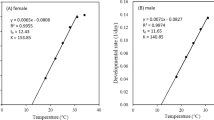Abstract
In the genus Strongyloides, larval development external to the host is known to be markedly affected by a variety of environmental factors. This investigation focuses on the effect of temperature on Strongyloides ratti. Low temperature (15°C) was shown to favor direct development, producing infective larvae, while high temperature (25°C) favored indirect development, producing free-living females and males. Different courses of development were brought about by either a 16-h temperature stimulus at 15°C or a 6-h temperature stimulus at 25°C. Moreover, eggs were not susceptible to the cold-temperature stimulus of 15°C, while newly hatched larvae were. The results indicate that the developmental course of S. ratti larvae external to the host is determined at a relatively early stage before the first molt.




Similar content being viewed by others
References
Arizono N (1976) Studies on the free-living generations of Strongyloides planiceps Rogers, 1943. II. Effect of temperature on the developmental types. Jap J Parasitol 25:328–335
Barrett J (1968) The effect of temperature on the development and survival of the infective larvae of Strongyloides ratti Sandground, 1925. Parasitology 58:641–651
Fenton A, Paterson S, Viney ME, Gardner MP (2004) Determining the optimal developmental route of Strongyloides ratti: an evolutionarily stable strategy approach. Evolution 58:989–1000
Harvey SG, Gemmill AW, Read AF, Viney ME (2000) The control of morph development in the parasitic nematode Strongyloides ratti. Proc R Soc Lond B 267:2057–2063
Keiser PB, Nutman TB (2004) Strongyloides stercoralis in the immunocompromised population. Clin Microbiol Rev 17:208–217
Kimura E, Shintoku Y, Kadosaka T, Fujiwara M, Kondo S, Itoh M (1999) A second peak of egg excretion in Strongyloides ratti-infected rats: its origin and biological meaning. Parasitology 119:221–226
Minematsu T, Mimori T, Tanaka M, Tada I (1989) The effect of fatty acids on the developmental direction of Strongyloides ratti first-stage larvae. J Helminthol 63:102–106
Nwaorgu OC (1983) The development of the free-living stages of Strongyloides papillosus I. Effect of temperature on the development of the heterogonic and homogonic nematodes in faecal culture. Vet Parasitol 13:213–223
Premvati (1958) Studies on Strongyloides of primates II. Factors determining the “direct” and the “indirect” mode of life. Can J Zool 36:185–195
Shiwaku K, Chigusa Y, Kadosaka T, Kaneko K (1988) Factors influencing development of free-living generations of Storngyloides stercoralis. Parasitology 97:129–138
Taylor KA, Weinstein PP (1990) The effect of oxygen and carbon dioxide on the development of the free-living stages of Strongyloides ratti in axenic culture. J Parasitol 76:545–551
Viney ME (1996) Developmental switching in the parasitic nematode Strongyloides ratti. Proc R Soc Lond B 263:201–208
Viney ME (1999) Exploiting the life cycle of Strongyloides ratti. Parasitol Today 15:231–235
Author information
Authors and Affiliations
Corresponding author
Rights and permissions
About this article
Cite this article
Minato, K., Kimura, E., Shintoku, Y. et al. Effect of temperature on the development of free-living stages of Strongyloides ratti . Parasitol Res 102, 315–319 (2008). https://doi.org/10.1007/s00436-007-0773-7
Received:
Accepted:
Published:
Issue Date:
DOI: https://doi.org/10.1007/s00436-007-0773-7




